WFD Fitness Check ! Be ready !
The Water Framework Directive (WFD), which has made great works in protecting and restoring our rivers, lakes and groundwaters, is under fitness check by the European Commission.
To make our voices heard, and protect our rivers, get ready to participate at the public consultation which will be launched in september or october 2018.
We must show that people care about our rivers and don’t want this ambitious and important policy for our living well to be weakened. To protect our lakes and rivers we need to protect the WFD
Sign up (on our Big Jump website) to get informed of the launch of the public consultation. www.bigjump.org/en/participant-form/
Read more www.ern.org/en/living-rivers-europe
We need your help to upgrade our statement to our governments : we need to preserve the ambition of the WFD.
Big Jump, J-6 ! Are you ready ?
One simple jump. It’s easy for us – but it means a lot to our rivers. Come and join us to protect our rivers on Sunday 8 July. Yes, that’s the day of the Big Jump.
List of events and registration on www.bigjump.org
To send a message to our government, grab a pebble, draw a heart on it to express you care about our rivers. Then on the day of the Big Jump, send it skipping into a river near to you. Share on social media !
Big Jump is a European wide event that raises awareness about our rivers, and brings people together to express their willingness to protect them.
#ProtectWater #BigJump #BigJumpForRivers
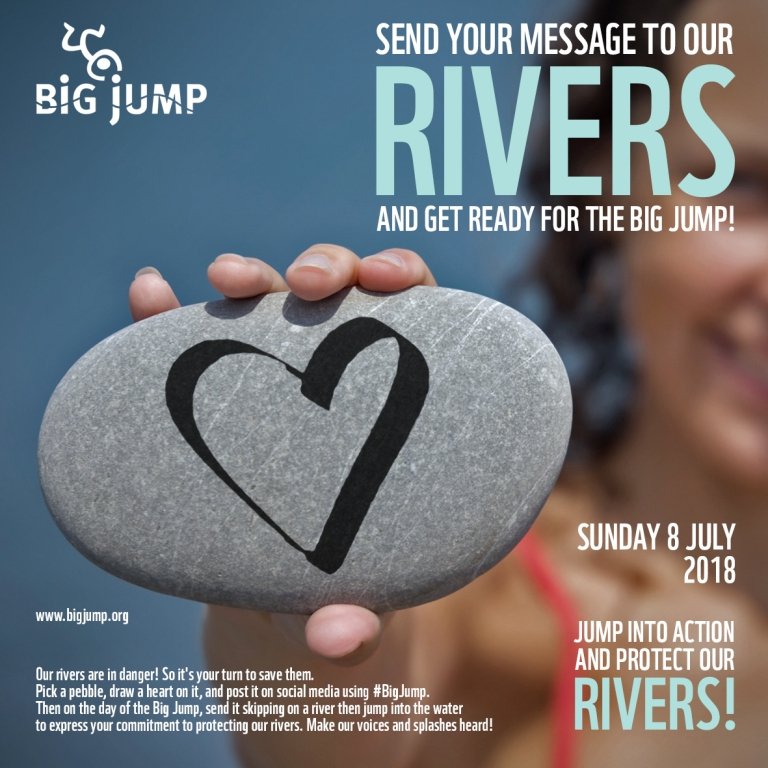
15 of May : First screening in France of the film «Blue Heart», produce by Patagonia
Patagonia will present his new movie “Blue Heart” in France the 15 of May 2018, at Paris Mk2 cinema.
Second movie produce by Patagonia after Dam Nation, this film is part of the campaign “Save the Blue Heart of Europe“.
ERN France (Roberto Epple) is invited to participate to the debate which will follow the screening. Zoé Heart, Patagonia’s ambassadress will also be present.
Watch the trailer :
All screening dates : https://blueheart.patagonia.com/intl/en/film
Living Rivers Europe – Press Release on Word Fish Migration Day : Dams have had their day – EU governments must ramp up ambition on their removal
Dams have had their day: EU governments must ramp up ambition on their removal
Brussels – 19 April 2018
World Fish Migration Day – which takes place on 21 April – is a day to celebrate the incredible journey migratory fish undertake to mate. But many never reach their final destination due to tens of thousands of large and small dams, which have been wrecking Europe’s rivers and blocking fish migration routes for generations. And if that weren’t enough, plans for thousands of additional dams are still in the pipeline.
Sergiy Moroz, Senior Policy Officer for Water and Biodiversity at the European Environmental Bureau (EEB) said: “Fragmenting rivers with dams, barrages and other infrastructure is a key reason for the significant losses of fish and other freshwater species across Europe, as well as for the poor state of many of our water bodies [1]. Removing old or obsolete dams helps to restore a river’s connectivity, bringing hope for migratory fish species, such as salmon, eel and sturgeon. This is also one effective way for Member States to meet their legal commitments under the EU Water Framework Directive.”
Despite the destructive effect they have had on our rivers, thousands of hydropower dams are projected to be built all across Europe. Eastern Europe and the Balkans, which hold some of Europe’s most pristine and last few remaining free flowing rivers, are especially vulnerable. However, there has also been a worrying surge in hydropower in parts of Central and Western Europe, where rivers have been heavily modified and degraded for centuries – in Austria alone, around 200 additional hydropower plants are projected to be built.
And there are even plans to resuscitate projects that have been repeatedly declared dead. For instance, the Acheloos River in Greece has been the site of a battle against a water transfer project dating back to the 1980s, which would involve the construction of four dams. The destructive scheme has been blocked through six court rulings, most recently thanks to the Water Framework Directive [2], but the Greek government still hopes to complete the construction of the partly-built Sykia dam – the key point for the completion of the project.
“Dams have had their day in Europe – we must now focus on bringing life back to our rivers”, said Andreas Baumüller, Head of Natural Resources at WWF’s European Policy Office, “It is crucial that EU governments now fully commit to their legal obligations under the Water Framework Directive. It’s time for them to shape up, start taking dam removal seriously, and put a firm stop to any damaging projects that are in the pipeline.”
Dam removals have slowly started to pick up the pace in Europe, and the Water Framework Directive’s ambitious goals, timeline, and visionary approach to water management have been instrumental. It is estimated that around 4,500 obstacles of varying sizes have so far been removed in Europe [3] and, just last year, the French government announced the largest dam removal in Europe to date [4]. Work also began last week on removing the Yecla de Yeltes dam in Spain [5] and the demolition of a number of obstacles in Finland, Spain and the Netherlands are also on the cards.
“These removals are a step towards bringing Europe’s rivers back to life, but there is still a long way to go”, said Mark Owen of the European Anglers Alliance “Dams have dire consequences for migratory fish species, and they also degrade the biodiversity in and around these rivers. We need fewer obstacles and more free flowing rivers, otherwise the EU will never be able to halt biodiversity loss by 2020, as required by its own biodiversity strategy [6].”
_____________________________________________________________________________________
Notes to the editors:
[1] The State of Nature in the EU, European Commission, 2015
[2] The Water Framework Directive was the basis for the latest ruling from the Greek Supreme Court on the Acheloos water transfer project in 2014
[3] ‘INTERVIEW with Dam Removal Europe’, Sustain Europe, 2018, http://www.sustaineurope.com/interview-with-dam-removal-europe-20180224.html
[4] ‘River revolution in Europe as France launches largest dam removal project on the continent’, WWF, 2017, http://www.wwf.eu/?uNewsID=317032
[5] ‘La CHD inicia el derribo de la presa de Yecla de Yeltes’, Salamanca RTV al día, 2018, http://salamancartvaldia.es/not/177064/chd-inicia-demolicion-presa-yecla-yeltes/
[6] EU Biodiversity Strategy, European Commission, 2011
> Link to Living Rivers Europe’s position paper
>About the Water Framework Directive
- The Water Framework Directive is one of the EU’s most progressive pieces of environmental legislation. It requires the protection, enhancement and restoration of our rivers, wetlands, lakes and coastal waters, but Member States are currently failing make it work on the ground;
- Under the Water Framework Directive, EU governments have committed to ensure no deterioration and achieve good status for the vast majority of all water bodies by 2015, and at the very latest by 2027;
- Where implemented, the Water Framework Directive has proved to be effective in achieving its goals of good water status and non-deterioration, successfully balancing environmental, social and economic requirements.
For more information please contact:
Sophie Bauer, Communications Officer (Freshwater), WWF European Policy Office
+32 471 05 25 11
Download the Press Release in pdf
The 21 of April it’s the “World Fish Migration Day” : participate
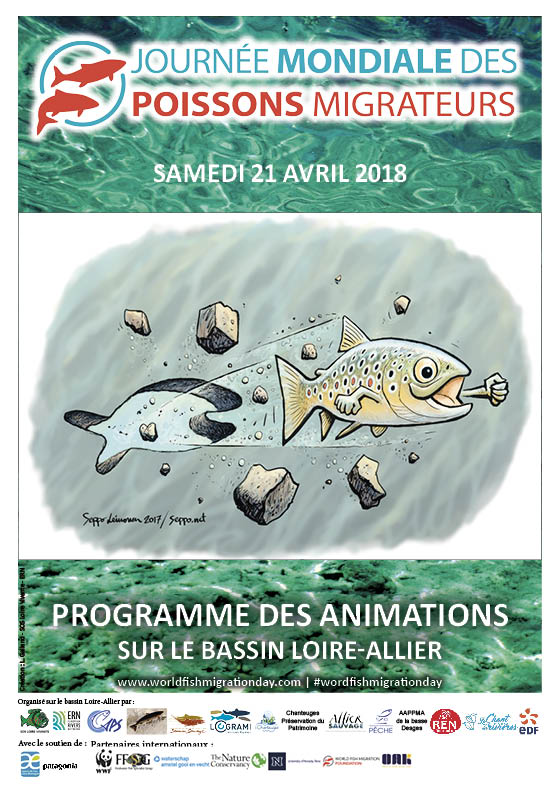
The World Fish Migration Day (WFMD) is a one day global celebration to create awareness on the importance of open rivers and migratory fish and it is coordinated by the World Fish Migration Foundation. On World Fish Migration Day organizations from around the world organize their own event around the common theme of: CONNECTING FISH, RIVERS AND PEOPLE. Many of these events are open to the public. By working together we create a greater driving force to raise awareness, share ideas and secure commitments.
Presse release : french events on Loire basin – in french
All events on : https://www.worldfishmigrationday.com/events
Support the campaign “Save the Blue Heart of Europe” launched by Patagonia
Patagonia is launching first ever global environmental campaign focusing on a European issue: protecting the last wild rivers of Europe from the threat of 3,000 planned hydro projects.
No money= No dams. Tell international banks to stop investing in the destruction of Europe’s last wild rivers. #savetheblueheart
Sign the petition: pat.ag/TheDamTruth
More info and to participate : « Save the Blue Heart of Europe »
Living Rivers Europe – Press Release on Word Water Day : stop damming of the Mura River
77,000+ citizens call on Slovenian government to stop damming of the Mura River
Brussels – 22 March 2018
On World Water Day, Living Rivers Europe – a coalition of five environmental and angling organisations – is calling for Slovenia to abandon plans to erect eight hydropower dams across the Mura River, which would transform this healthy free-flowing river into eight lifeless reservoirs. Living Rivers Europe is the European Anglers Alliance, the European Environmental Bureau, the European Rivers Network, Wetlands International and WWF, who together represent a movement of over 40 million people across Europe.
The planned dams violate both Slovenian and EU water and nature conservation laws and will wreck the Mura River, blocking fish migration routes and the flow of sediment – threatening fish populations as well as wildlife that depend on the river. The river also provides invaluable services to local communities. Not only is it the most important source of drinking water, it also provides natural flood protection and is a valuable recreational area.
“In addition to the environmental and economic consequences, moving forward with these planned dams goes against the Slovenian government’s commitment to ensure international protection of the future Transboundary UNESCO Biosphere Reserve, which will combine the cluster of thirteen protected areas along the Mura-Drava-Danube region”, said Cy Griffin, European Programme Manager at Wetlands International.
In a campaign driven by WWF together with other environmental NGOs, 77,310 people signed a petition calling for the damming of the Mura River to be halted. The signatures will be handed to the Slovenian government today – if these harmful plans are not scrapped, a formal complaint will then be issued to the European Commission outlining how they violate both the Water Framework Directive and Natura 2000.
The case of the Mura River is not an isolated one. All across Europe, rivers and other freshwater ecosystems are being destroyed at an alarming rate. Out of all the ecosystem types, freshwater ecosystems are continuing to experience the most significant deterioration, as both European Environment Agency [1] and WWF’s own research show. Indeed, according to WWF’s Living Planet Report, the abundance of freshwater species worldwide has shrunk by 81% since the 1970s [2]. Agricultural pollution, over-abstraction of water, the construction of hydropower dams, flood defences and navigation all alter the natural state of rivers through physical modification, such as water pumping, channelizing, dredging, and gravel and sand extraction, with disastrous consequences for the environment.
“Our rivers are dying right under our eyes. As Living Rivers Europe, we aim to restore and protect rivers such as Mura for wildlife and for people. Unless we act now, our rivers and the crucial services they provide will continue to deteriorate”, said Andreas Baumüller, Head of Natural Resources at WWF’s European Policy Office, “Back in 2000, EU Member States committed to protect and restore freshwater habitats in Europe through the adoption of the EU Water Framework Directive. Slovenia needs to live up to its legal commitments and scrap these destructive dams. Other countries should also focus on reviving the ambition set out in these visionary laws rather than on trying to side-step them.”
Living Rivers Europe believes that the Water Framework Directive is the only way to turn back the clock on the destruction of Europe’s waters. The Directive has been in effect for 18 years now, and has resulted in some improvements in the status of the EU’s water bodies. However, Member States have been reluctant to make this ambitious legislation work on the ground, bowing instead to economic pressures from industry and farmers. This resulted in the Directive’s goal of achieving good status for the vast majority of Europe’s waters by 2015 being missed by a long shot, with the latest data suggesting that not even half of all rivers, lakes and wetlands in Europe are currently healthy.
“The Water Framework Directive is currently undergoing its scheduled review. Some Member States may see this review period as an opportunity to weaken the Directive’s high standards on freshwater protection, to the detriment of people and nature”, said Mark Owen of the European Anglers Alliance, “The European Anglers Alliance, together with its partners from Living Rivers Europe, will be there every step of the way during this crucial review period to ensure that it is used to strengthen implementation of the Directive, rather than weaken its standards.”
_________________________________________________________________________
Notes to the editors:
[1] The State of Nature in the EU, European Commission, 2015
[2] Living Planet Report, WWF, 2016
> Link to WWF’s campaign to save the Mura River
> Link to Living Rivers Europe’s position paper
> About freshwater ecosystems in Europe and the Water Framework Directive
- Healthy freshwater ecosystems are crucial for people, nature and economies: not only do they supply and purify our water; they also help us adapt to and mitigate the impacts of climate change by storing carbon and ensuring better flood control. The majority of economic sectors and industries, including food production, are also reliant on freshwater ecosystems and many people’s livelihoods depend on freshwater fish populations;
- Living Rivers Europe considers the Water Framework Directive to be one of the EU’s most progressive pieces of environmental legislation. It requires the protection, enhancement and restoration of our rivers, wetlands, lakes and coastal waters, but Member States are currently failing make it work on the ground;
- Under the Water Framework Directive, EU governments have committed to ensure no deterioration and achieve good status for the vast majority of all water bodies by 2015, and at the very latest by 2027;
- Where implemented, the Water Framework Directive has proved to be effective in achieving its goals of good water status and non-deterioration, successfully balancing environmental, social and economic requirements.
- The economic potential of full implementation of the Directive is significant: if Europe had met its 2015 deadline, the expected total yearly benefits could have reached €20 billion per year on average. [1]
> Living Rivers Europe’s key asks:
1. Improved implementation and enforcement of the Water
- Framework Directive, including:More ambitious River Basin Management Plans (RBMPs);
- Ensuring that all exemptions from the Water Framework Directive’s objectives are applied restrictively and in exceptional cases only in order to uphold the purpose and effect of the Directive;
- Increased use of nature-based solutions for tackling the impacts of floods and drought;
- Ensuring that payment for water is based on fair pricing and that those who pollute it also have to pay;
- Ensuring that the remaining free-flowing and unaltered stretches of rivers in Europe are effectively protected and that their biodiversity and ecological values are not compromised by hydropower and inland navigation development.
2. Effective integration of water management aspects into relevant sectoral policies, particularly agriculture, energy and transport.
3. The Water Framework Directive is currently undergoing its scheduled review (in the form of a fitness check): in order to meet the ultimate 2027 deadline, the review should be used to strengthen implementation of the Directive, rather than weaken its standards.
For more information please contact:
Sophie Bauer, Communications Officer (Freshwater), WWF European Policy Office
sbauer@wwf.eu
+32 471 05 25 11
[1] Mattheiß V., De Paoli G. and Strosser P. (ACTeon) (2012) Comparative study of pressures and measures in the major river basin plans in the EU, Task 4 b: Costs & Benefits of WFD implementation (EU project), p. 35, 46.
Download the Press Release in pdf
On International Day of Action for Rivers, ERN’s press release and petition to save the Mura river in Slovenia
Hydropower, a disaster for our rivers !
>> Read ERN’s press release (in french) <<
WWF launched a campaign and a petition (until 22 march) to ask Slovenia’s governement to abandon plans to erect eight hydropower dams across the Mura River – Amazon of Europe -, which would transform this healthy free-flowing river into eight lifeless reservoirs.
Sign the petition.
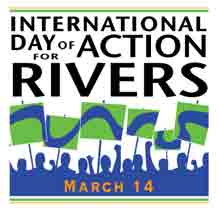
new leaflet : NO GO for micro hydro in french wild and scenic rivers
Only 1% of French river, mostly in national park, have a good statute of preservation, with a specific and endemic biodiversity. We need to save them from hydropower projects. This project causes too much damage on the rivers and do not participate to energetic transition. ERN France – Wild Rivers publishes a brochure with examples of 3 endangered beautyfull rivers.
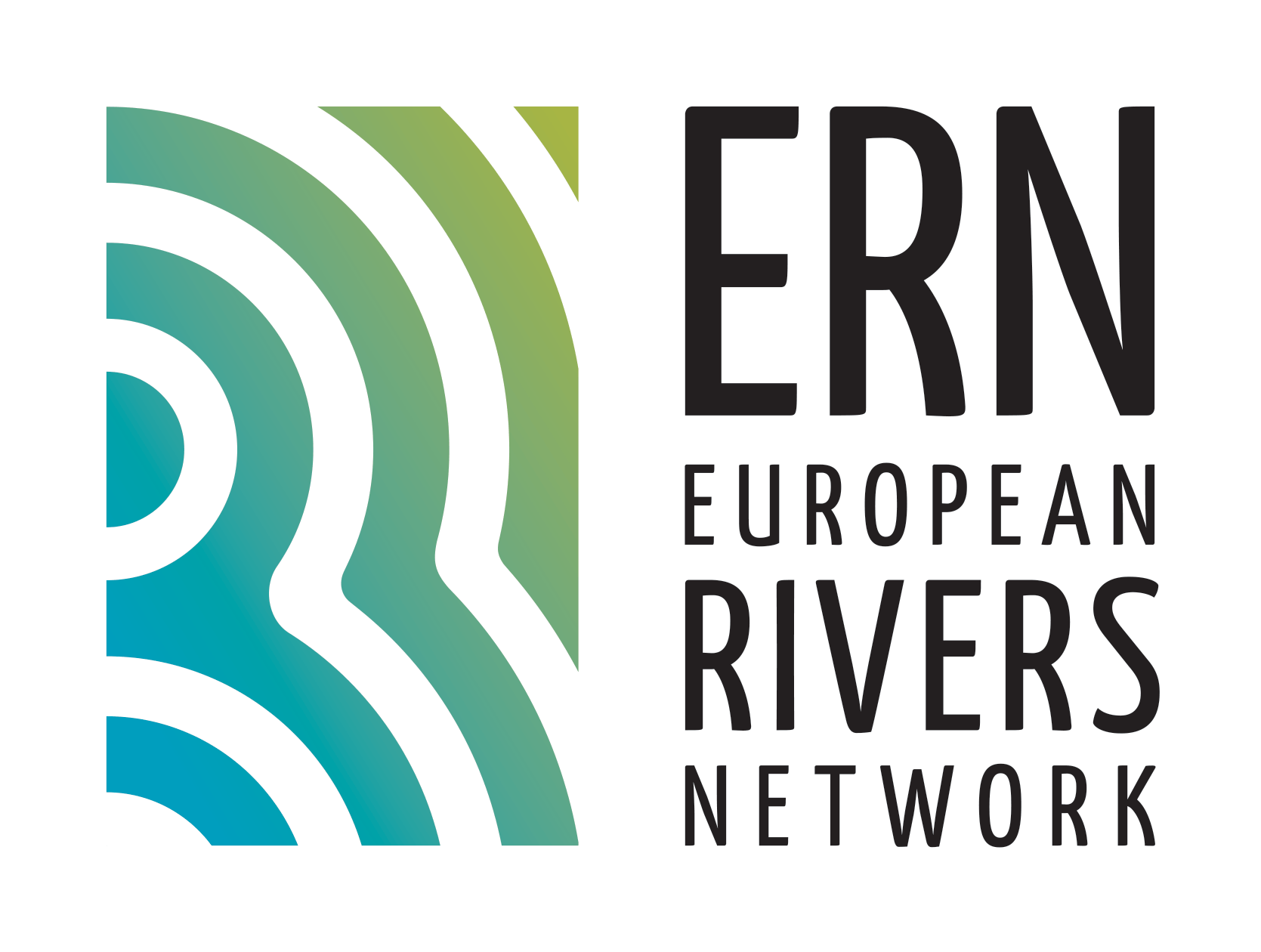
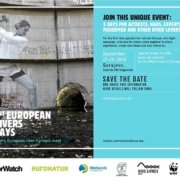
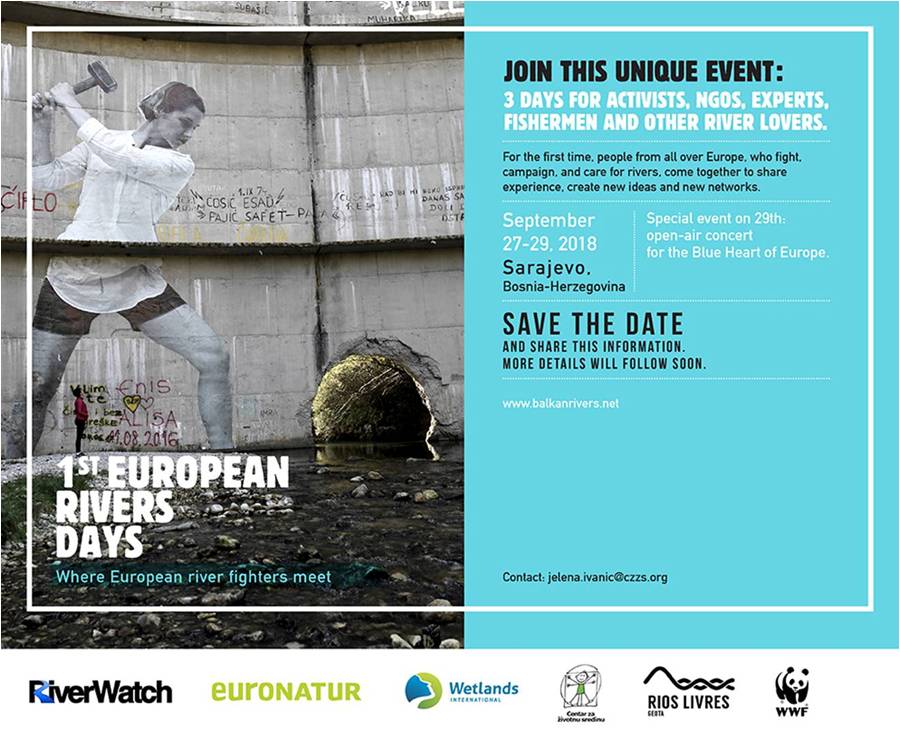
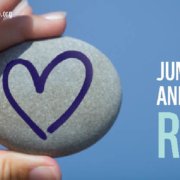
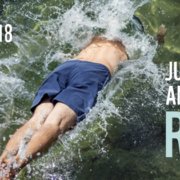
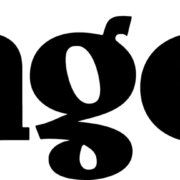
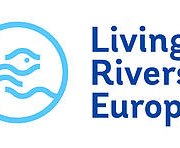


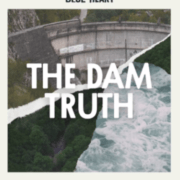
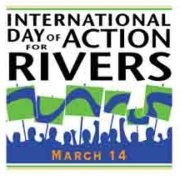
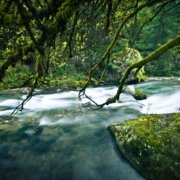
 ERN France
ERN France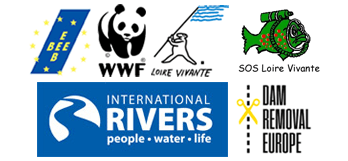 ERN is the official WWF Freshwater Partner in France and cooperates with WWF Switzerland, Austria, Netherlands and others
ERN is the official WWF Freshwater Partner in France and cooperates with WWF Switzerland, Austria, Netherlands and others